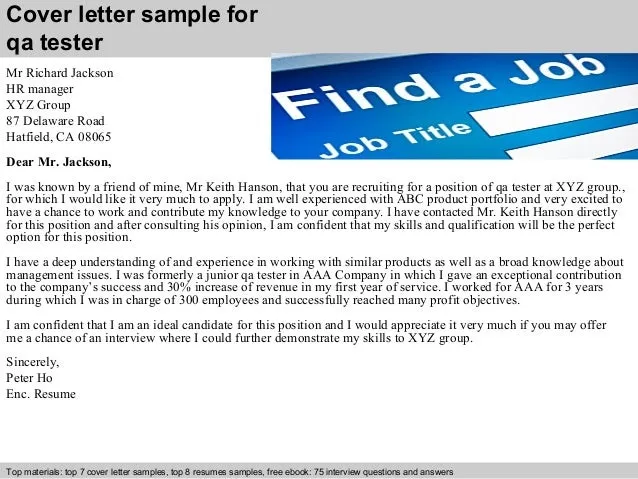Crafting Your QA Tester Cover Letter
A well-crafted cover letter is your initial opportunity to make a positive impression and demonstrate your suitability for a QA Tester role. It is a crucial component of your job application package, designed to introduce you to the hiring manager, showcase your skills and experience, and ultimately, secure an interview. It is not merely a formality; it’s a vital tool in your job search arsenal. This guide provides insights into crafting a compelling QA Tester cover letter that will capture the attention of potential employers and significantly increase your chances of getting hired.
Understanding the Purpose of a Cover Letter
The primary purpose of a cover letter is to provide context to your resume. It allows you to elaborate on your qualifications, explain your career goals, and express your enthusiasm for the position. It’s your chance to tell a story about why you are the perfect fit for the role and the company. Unlike your resume, which provides a factual summary of your experience, the cover letter lets you inject personality and demonstrate your communication skills. It offers an opportunity to connect with the hiring manager on a more personal level, highlighting your unique value proposition.
Key Components of a QA Tester Cover Letter
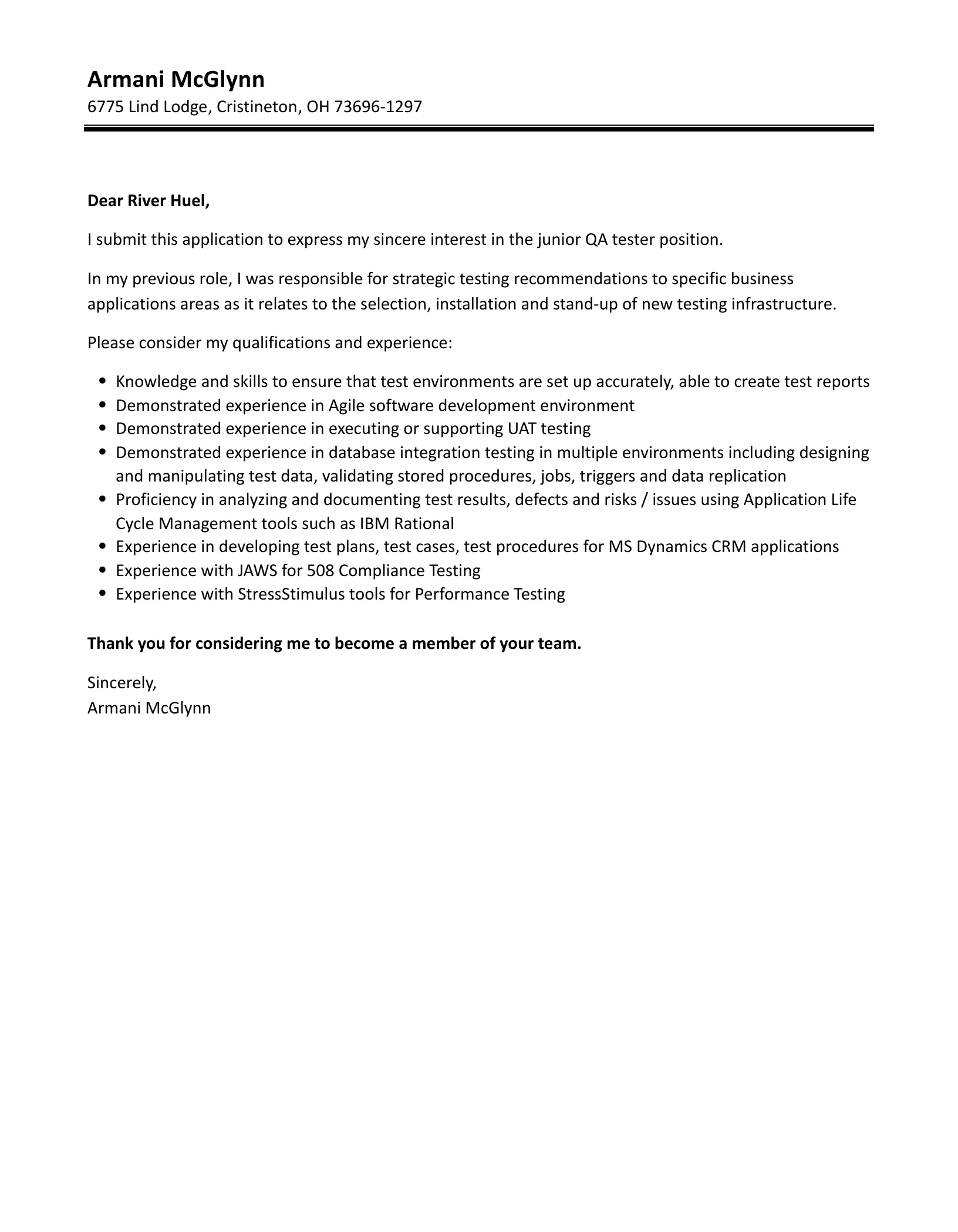
A strong QA Tester cover letter should include several key components to effectively convey your qualifications and interest. Each part plays a vital role in creating a cohesive and impactful application. These components work together to tell a compelling narrative, making your application memorable. Properly structured and carefully written, it is a powerful tool for showcasing your professional profile and increasing your chances of success. Neglecting any one of these aspects diminishes the overall effectiveness of your application.
Contact Information and Salutation
Begin with your contact information (name, phone number, email, and optionally, your LinkedIn profile URL) at the top. Then, address the hiring manager by name if possible. Research the company to find the hiring manager’s name. If you can’t find it, use a professional salutation like ‘Dear Hiring Manager’ or ‘Dear [Company Name] Hiring Team’. This personalized touch immediately captures the reader’s attention and shows you’ve taken the initiative to research the company and the role.
Writing a Compelling Introduction
Your introduction is your first and perhaps most important opportunity to grab the reader’s attention. State the position you’re applying for, how you found the job, and a brief, impactful statement about your relevant experience or a key skill. Avoid generic introductions. Instead, aim for a statement that immediately showcases why you are an excellent fit for the role. Consider mentioning a specific achievement or a skill that aligns perfectly with the job requirements to make a strong initial impression.
Highlighting Your QA Skills and Experience
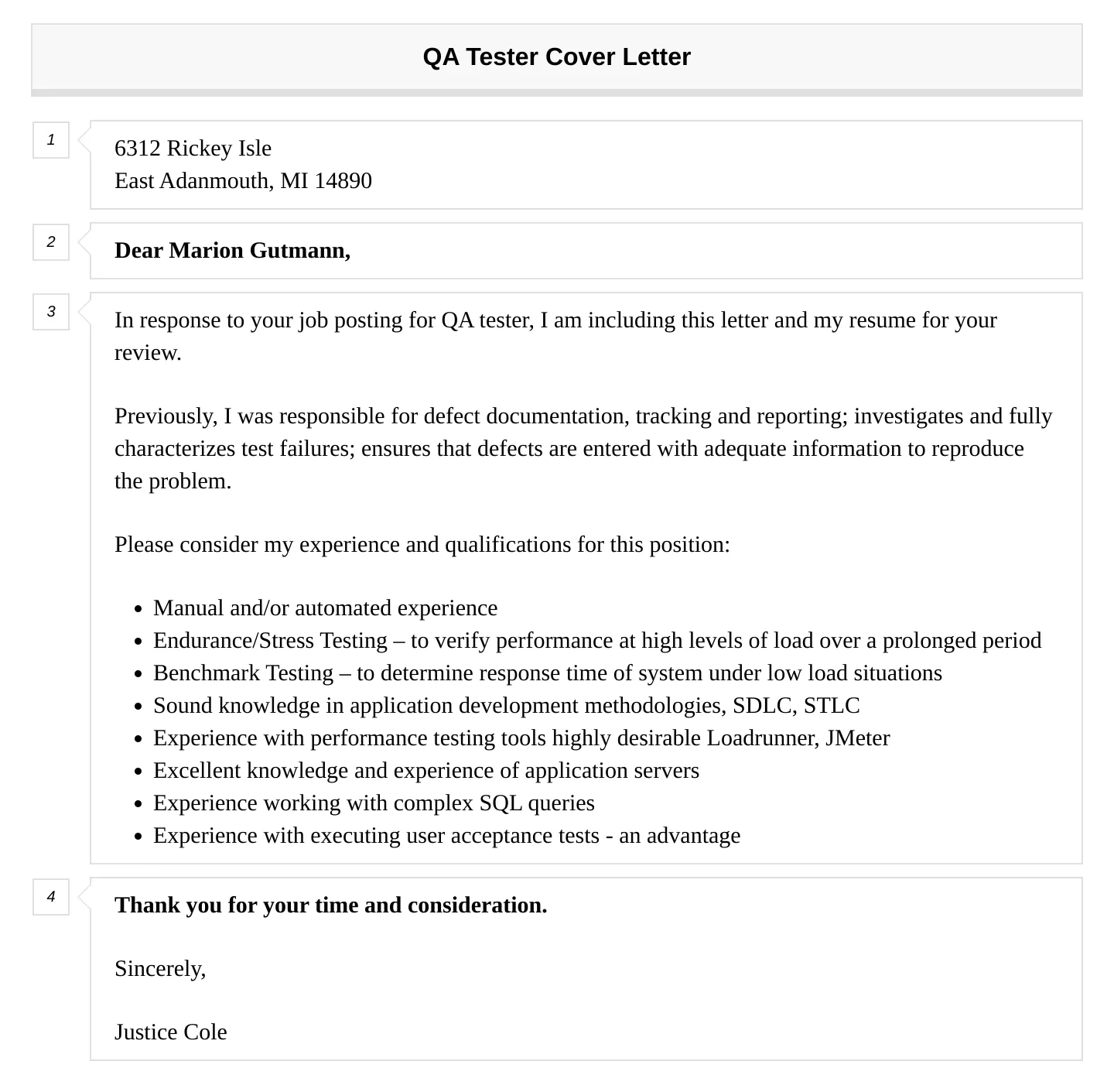
The body of your cover letter is where you demonstrate your skills and experience. Focus on the QA skills most relevant to the job description. Mention your proficiency in different testing methodologies (e.g., manual testing, automated testing, regression testing). Highlight your experience with specific testing tools, such as Selenium, JUnit, or TestRail. Back up your claims with specific examples of your past projects, achievements, and responsibilities. Use quantifiable data whenever possible to demonstrate your impact and value.
Mentioning Relevant Projects and Technologies
Showcase your experience with projects and technologies relevant to the role. Describe your involvement in these projects, including your role and the specific tasks you performed. Mention the types of software, hardware, or platforms you’ve tested. If you have experience with Agile or Scrum methodologies, highlight it. Tailor this section to match the specific requirements outlined in the job description, emphasizing your experience with the technologies and tools the employer uses.
Quantifying Achievements and Results
Whenever possible, quantify your achievements. Use numbers and data to demonstrate your impact in previous roles. For example, instead of saying ‘Improved testing efficiency,’ say ‘Improved testing efficiency by 20% by implementing automated testing scripts.’ Showcasing your ability to generate tangible results strengthens your claims and gives the employer a concrete understanding of your value. Quantifiable results show you’re not just doing the job; you’re excelling at it.
Demonstrating Your Passion for Quality Assurance
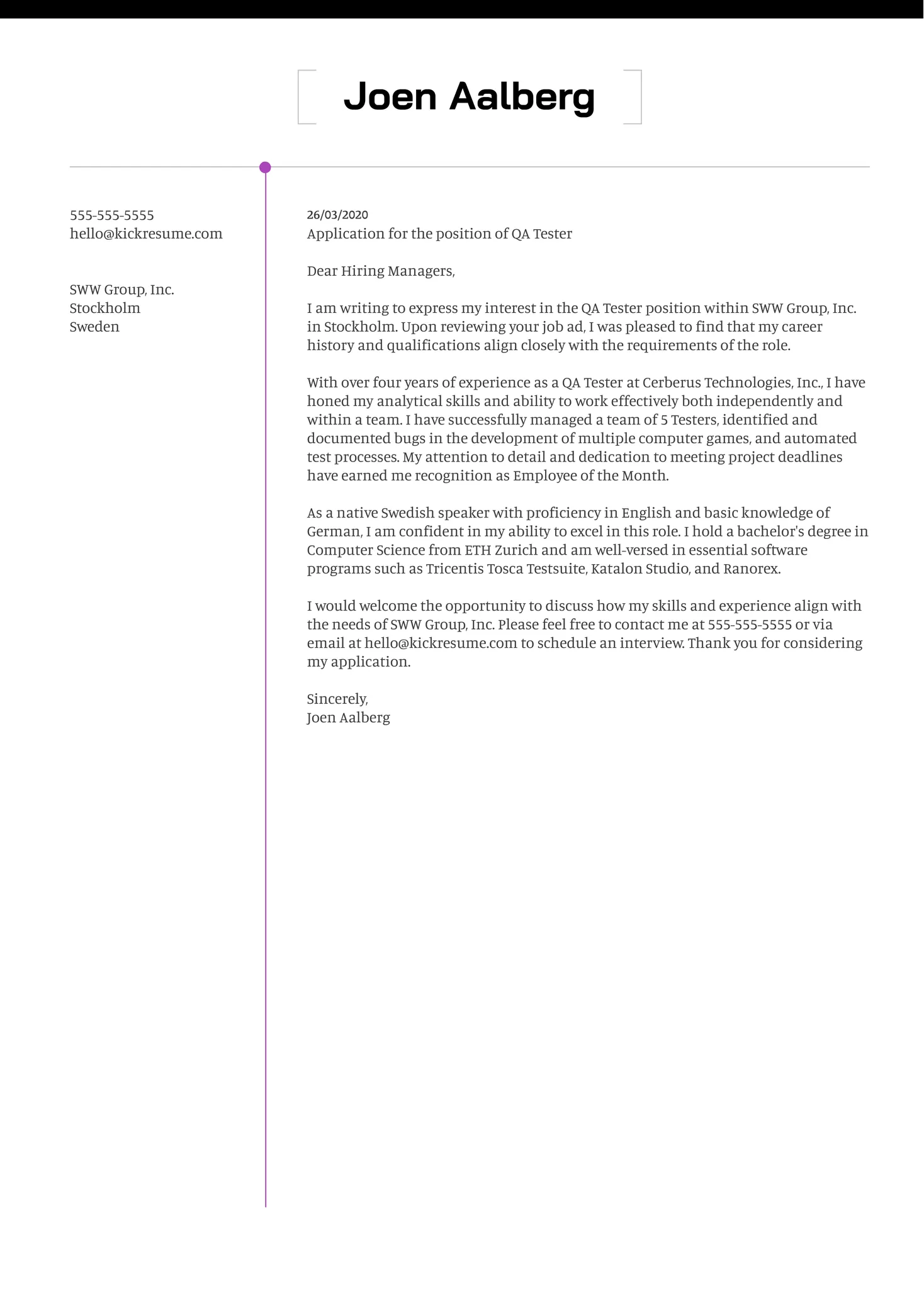
Express your enthusiasm for quality assurance. Explain what aspects of QA you find most appealing. Mention why you are passionate about ensuring the quality of software or products. This passion signals your dedication to the field and shows you’re committed to the role beyond simply meeting the requirements. A genuine passion for QA can make you stand out from other candidates. Your enthusiasm will make a positive impression on the hiring manager.
Showcasing Your Soft Skills
Highlight your soft skills, such as communication, teamwork, problem-solving, and attention to detail. These skills are crucial for QA testers. Provide examples of how you have used these skills in past roles. For instance, describe how you collaborated with developers to resolve bugs or how you clearly communicated complex technical issues to non-technical stakeholders. Demonstrating these soft skills indicates you are a well-rounded professional.
Tailoring Your Cover Letter to the Job Description
It is essential to customize your cover letter for each job application. Carefully read the job description and identify the key requirements and keywords. Then, highlight your skills and experiences that align with these requirements. Use the same language and terminology as the job description. Customize your cover letter to match the specific needs and expectations of the company and the role.
Researching the Company and the Role
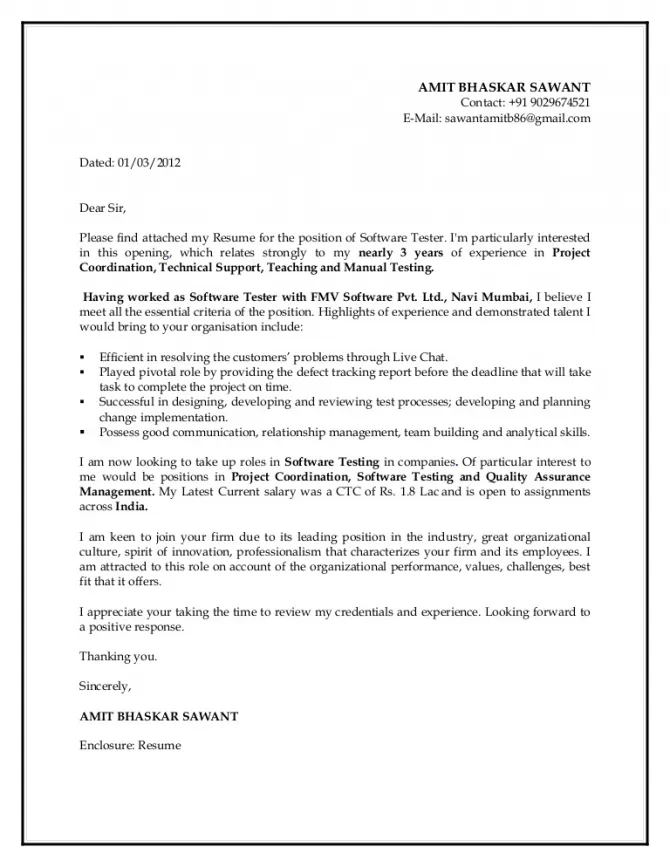
Before you write your cover letter, research the company and the specific role. Understand the company’s mission, values, and culture. Visit their website, read their news, and check their social media profiles. This research provides insights that allow you to tailor your cover letter to their needs and expectations. Knowing about the role helps you demonstrate how your skills align with their needs. Demonstrate that you are genuinely interested in the opportunity and the company.
Addressing the Hiring Manager’s Needs
Address the hiring manager’s specific needs in your cover letter. Identify the key skills, experience, and qualities the company is seeking. Align your skills and accomplishments with their requirements. Explain how you can solve their problems and contribute to their success. Demonstrate your ability to meet and exceed their expectations. Show you understand what the company is looking for in a QA tester.
Structuring Your Cover Letter Effectively
A well-structured cover letter is easy to read and understand. Divide your cover letter into clear paragraphs and sections to enhance readability. Use headings and subheadings to organize your content logically. Ensure your cover letter flows smoothly and logically. Keep your paragraphs concise and to the point. Well-structured content makes it easier for the hiring manager to quickly grasp your key qualifications and experiences.
Formatting for Readability and Impact
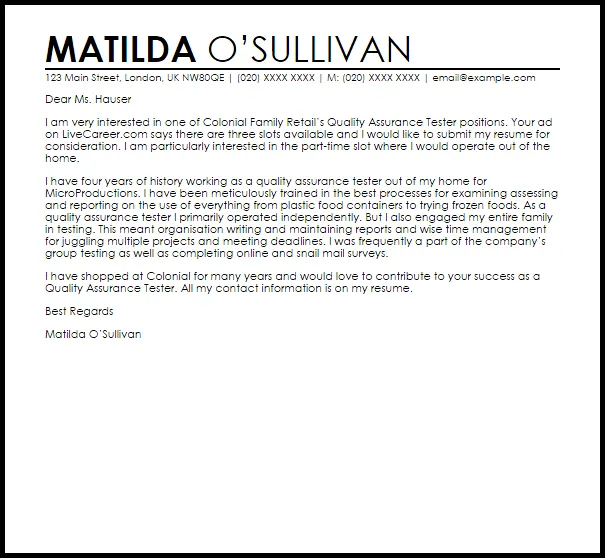
Use a professional and clean format for your cover letter. Choose a standard font like Arial, Calibri, or Times New Roman. Use 1-inch margins and single-space the text, with a blank line between paragraphs. Bold key phrases and use bullet points to highlight your accomplishments and skills. Good formatting enhances the overall readability and visual appeal. The visual appearance of your cover letter is important.
Choosing the Right Tone and Style
Adopt a professional and enthusiastic tone throughout your cover letter. Your tone should be confident and positive. Avoid sounding overly formal or casual. Show your personality while remaining professional. Use clear and concise language. Proofread your cover letter for any errors in grammar and spelling. The right tone and style will make your cover letter engaging and professional.
The Importance of Proofreading and Editing
Proofreading and editing are crucial steps in the cover letter writing process. Check your cover letter carefully for any errors in grammar, spelling, and punctuation. Errors undermine your credibility and demonstrate a lack of attention to detail, which is essential for a QA tester. Have someone else review your cover letter, as a fresh pair of eyes can catch errors you might miss. Thorough proofreading ensures your cover letter is polished, professional, and error-free.
Using Action Verbs to Describe Your Accomplishments
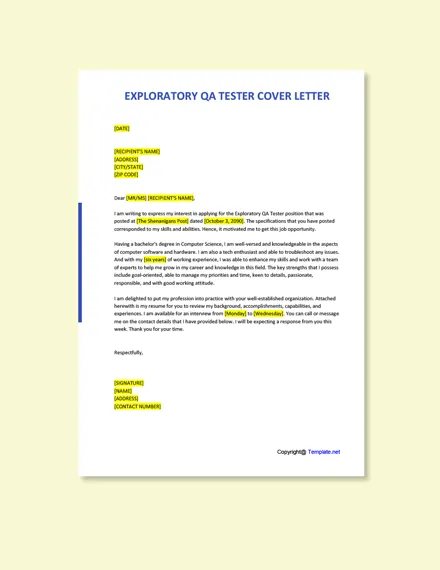
Use strong action verbs to describe your accomplishments and responsibilities. Action verbs bring your experiences to life and make your cover letter more dynamic and engaging. Instead of saying ‘Responsible for testing,’ use ‘Developed and executed test plans’. Choose verbs that accurately reflect your actions and achievements. Examples include ‘Implemented,’ ‘Managed,’ ‘Resolved,’ ‘Improved,’ and ‘Analyzed.’ Using active verbs makes your accomplishments stand out and captures the reader’s attention.
Creating a Strong Closing Statement
End your cover letter with a strong closing statement. Reiterate your interest in the position and the company. Summarize your key qualifications. Express your confidence in your ability to contribute to the company’s success. A compelling closing statement leaves a lasting positive impression on the hiring manager. Your closing statement should summarize your key points and reinforce your value.
Expressing Your Enthusiasm and Interest
Express your enthusiasm and genuine interest in the QA Tester role and the company. Show you are excited about the opportunity and the prospect of contributing to the team. Mention what specifically attracts you to the company or the role. Highlighting your enthusiasm demonstrates your commitment and dedication, which can set you apart from other candidates. Showing your genuine interest will help you stand out.
Including a Call to Action
Conclude with a clear call to action. State your availability for an interview and how the hiring manager can contact you. Thank the hiring manager for their time and consideration. A clear call to action encourages the hiring manager to take the next step. Make it easy for them to contact you and schedule an interview. End your cover letter on a positive note.
Reviewing QA Tester Cover Letter Samples
Reviewing cover letter samples can provide valuable insights and inspiration. Analyze successful cover letters written by other QA testers. Pay attention to how they structure their letters, showcase their skills, and highlight their achievements. Adapt these examples to your own situation, but avoid directly copying them. Learn from the best practices and tailor the strategies to your own experiences and the specific job requirements.
Analyzing Successful Cover Letters
Analyze successful cover letters to understand what makes them effective. Identify how the writers effectively convey their skills, experience, and enthusiasm. Pay attention to the language they use, the tone, and the structure of their letters. Look for common elements like strong introductions, well-defined skills sections, and compelling closing statements. Analyze how the writers tailor their letters to specific job descriptions and company requirements. Effective cover letters are well-written and tailored to specific needs.
Avoiding Common Mistakes in Cover Letters
Avoid common mistakes that can undermine your application. These mistakes can negatively impact your chances of getting an interview. By being aware of these pitfalls, you can create a cover letter that highlights your qualifications and increases your chances of success. Make sure you carefully proofread your cover letter before submitting it. Proofread your cover letter several times to ensure accuracy.
Grammar and Spelling Errors
Grammar and spelling errors are unacceptable in a professional cover letter. Errors can make you seem careless and unprofessional, which is detrimental to your candidacy. Always proofread your cover letter carefully. Use a spell checker and grammar checker. Consider having someone else review your cover letter. Proofread your cover letter meticulously. Check for inconsistencies in formatting, capitalization, and punctuation.
Generic and Uninspired Content
Avoid using a generic and uninspired cover letter that could be used for any job. Tailor your letter to the specific requirements of the QA Tester role and the company. Make your cover letter unique and memorable. Show you have researched the company and understand their needs. Use specific examples and accomplishments to demonstrate your value. Personalized content shows you are genuinely interested in the position and demonstrates your attention to detail. Generic content fails to capture the reader’s attention.
Focusing on Yourself Instead of the Employer
Focus on how you can benefit the employer, not just what the job can do for you. Explain how your skills and experience align with their needs. Show how you can contribute to their goals and solve their problems. Demonstrating that you understand their needs is crucial. Show that you can deliver results for the employer.
Submitting Your Cover Letter
Ensure you submit your cover letter correctly. Include it with your resume as a single PDF document, unless the application instructions specify otherwise. Always follow the company’s instructions precisely. Submitting your application correctly shows your attention to detail and ability to follow instructions, which are vital for a QA tester.
File Format and Naming Conventions
Use a professional file format, such as PDF. Name your file appropriately (e.g., ‘YourName_CoverLetter_QATester’). Use this format to name your file to make it easy for the hiring manager to identify your application. A clear and professional file name makes it easier for the hiring manager to manage multiple applications.
Following Up After Submission
Follow up on your application a week or two after submitting it. Send a brief email to the hiring manager or recruiter, reiterating your interest in the position and mentioning your qualifications. A follow-up demonstrates your proactive approach and continued interest. Mention that you are available for an interview. It shows that you are eager for the position and want to pursue the role.
Tips for Getting Hired as a QA Tester
In addition to a well-crafted cover letter, there are other steps you can take to increase your chances of getting hired as a QA Tester. These tips can help you stand out from the competition and increase your success. These tips will help you get a competitive edge.
Preparing for the Interview
Prepare for the interview by researching the company and the role. Practice answering common interview questions, such as ‘Tell me about yourself’ and ‘Why are you interested in this role?’ Prepare examples of your QA skills and experience. Review your resume and cover letter and be ready to elaborate on anything you mentioned. Demonstrate your knowledge of the company. Prepare questions to ask the interviewer, showing your interest in the position. Proper preparation is crucial.
Highlighting Your QA skills again
Consistently highlight your QA skills throughout the application process. In your cover letter, resume, and interview, clearly and concisely state your skills. Be prepared to provide specific examples of your successes and how you used these skills in past roles. Tailor your skills to match the job requirements. Emphasize your relevant skills and accomplishments. Showing your skills in action will make a lasting impression.
